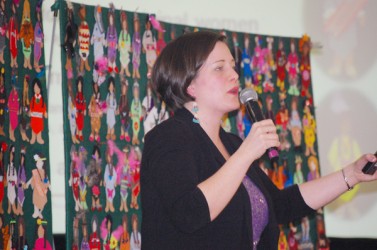Article Origin
Volume
Issue
Year
There is an important piece to the issue of murdered and missing Aboriginal girls and women that Mikisew Cree First Nation Chief Steve Courtoreille wants to see addressed.
“We have to educate our children,” he said. Educate girls on being safe and educate boys about treating girls and women with respect. “We want to send a strong message to the youth.”
The community of Fort Chipewyan, which includes the Mikisew Cree, Athabasca Chipewyan First Nation and Métis Local 125, will be the initial host site for a day of presentations from the RCMP KARE Unit and special guest speakers.
“By the time (the girls and women) get to the city, it’s almost too late to reach out to these women. They’re so entrenched in drugs, alcohol and the sex-trade that it’s like putting a band-aid on a gaping wound at that point,” said RCMP Cpl. Joe Veraeghe, with the KARE Unit in Edmonton. KARE was formed in 2003 as a project to investigate the large numbers of murdered and missing women. It has continued as a full unit of the RCMP.
The pilot project, which Veraeghe also hopes to deliver with Frog Lake and Blood First Nations, came about through discussions with a number of Aboriginal women’s groups in Edmonton. Veraeghe suggested the in-community presentations and Courtoreille responded immediately.
“This is even more pro-active. Take it back a step. Take an education awareness campaign back to the First Nations communities and reach out to the school-aged girls and the women who are still in the communities,” said Veraeghe, who would like to see the project rolled out province-wide.
For Courtoreille and the Mikisew Cree First Nation, the personal tragedy of missing and murdered women was brought home last year when the body of Amber Tuccaro, who had been missing since August 2010, was discovered in a field east of Leduc.
Tuccaro, who had flown to Edmonton for a doctor’s appointment, did not fit the usual profile.
“It could happen to anybody,” Courtoreille said.
Courtoreille got a first-hand look at vulnerable girls and women on the streets in Edmonton last month when he accompanied Veraeghe on a Friday-night street patrol. It is Veraeghe’s job to talk to the women, most of whom are Aboriginal and most of whom are involved in the sex-trade, to get their details so if they go missing or are murdered he has the information necessary to open a file on them.
Veraeghe and a working group in Fort Chipewyan are determining the presentations that would best meet the needs of the grades seven to 12 girls in the community. Presentations will include RCMP units on domestic violence, human trafficking, and gang violence. Feedback from those presentations will help determine what will be delivered in other First Nations communities.
Only time will tell, says Veraeghe, about the long term impact of talking to the girls before they come to “the bright lights, big city.”
Courtoreille says that the KARE day of presentations will be only one step in raising awareness in his community.
“We have to have something that’s going to be continuous,” he said.
He is hoping that Vivian Tucarro, Amber’s mother, will speak to the girls.
“You want to send a strong message to the youth and that strong message would come from a mother like Vivian. It’s going to hit home for a lot of the families because they know Amber,” said Courtoreille.
But the issue goes beyond the girls going to the cities and becoming victims. Victimization happens at home as well.
“When you start talking about missing/murdered, some people get the perception it’s white males who are murdering Aboriginal females. That’s not entirely the case. There’s a lot of domestic violence situations. It’s happening right in their own communities that women are being murdered. So we’re addressing everything,” said Veraeghe.
Courtoreille agrees.
“Our role as men is protectors, not abusers,” he said.
In April, the Assembly of First Nations and the Native Women’s Association of Canada hosted a two-day national forum in Edmonton on Community Safety and Ending Violence. The push for a public national enquiry on missing and murdered Aboriginal women and girls continued.
While Courtoreille says the public national enquiry is important and the closure it would give to families is invaluable, he holds that action needs to be taken to bring down those numbers of missing and murdered women and girls.
“I’d also like to see all the Chiefs stand up, be counted, and end violence against women. As men, we have a responsibility,” he said.
Photo caption: Remembering murdered, missing Aboriginal women, girls
Jennifer Lord, strategic policy liaison with the Native Women’s Association of Canada, led a workshop in Edmonton as part of a two-day national forum on Community Safety and Ending Violence. The faceless dolls are made by family and friends to honour missed and murdered women and girls. NWAC numbers indicate over 600 murdered or missing Aboriginal women in the past two decades, with Alberta and British Columbia having the highest numbers.
- 12050 views

